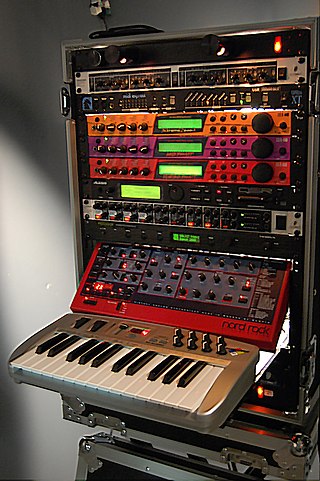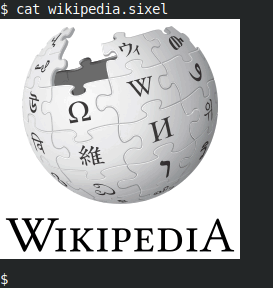
MIDI is a technical standard that describes a communication protocol, digital interface, and electrical connectors that connect a wide variety of electronic musical instruments, computers, and related audio devices for playing, editing, and recording music.
MIDI time code (MTC) embeds the same timing information as standard SMPTE timecode as a series of small 'quarter-frame' MIDI messages. There is no provision for the user bits in the standard MIDI time code messages, and SysEx messages are used to carry this information instead. The quarter-frame messages are transmitted in a sequence of eight messages, thus a complete timecode value is specified every two frames. If the MIDI data stream is running close to capacity, the MTC data may arrive a little behind schedule which has the effect of introducing a small amount of jitter. In order to avoid this it is ideal to use a completely separate MIDI port for MTC data. Larger full-frame messages, which encapsulate a frame worth of timecode in a single message, are used to locate to a time while timecode is not running.
Octal is a numeral system with eight as the base.
Short Message Peer-to-Peer (SMPP) in the telecommunications industry is an open, industry standard protocol designed to provide a flexible data communication interface for the transfer of short message data between External Short Messaging Entities (ESMEs), Routing Entities (REs) and SMSC.
A computer number format is the internal representation of numeric values in digital device hardware and software, such as in programmable computers and calculators. Numerical values are stored as groupings of bits, such as bytes and words. The encoding between numerical values and bit patterns is chosen for convenience of the operation of the computer; the encoding used by the computer's instruction set generally requires conversion for external use, such as for printing and display. Different types of processors may have different internal representations of numerical values and different conventions are used for integer and real numbers. Most calculations are carried out with number formats that fit into a processor register, but some software systems allow representation of arbitrarily large numbers using multiple words of memory.
In computer science, an escape sequence is a combination of characters that has a meaning other than the literal characters contained therein; it is marked by one or more preceding characters.

ANSI escape sequences are a standard for in-band signaling to control cursor location, color, font styling, and other options on video text terminals and terminal emulators. Certain sequences of bytes, most starting with an ASCII escape character and a bracket character, are embedded into text. The terminal interprets these sequences as commands, rather than text to display verbatim.

General MIDI is a standardized specification for electronic musical instruments that respond to MIDI messages. GM was developed by the American MIDI Manufacturers Association (MMA) and the Japan MIDI Standards Committee (JMSC) and first published in 1991. The official specification is available in English from the MMA, bound together with the MIDI 1.0 specification, and in Japanese from the Association of Musical Electronic Industry (AMEI).
Commodore BASIC, also known as PET BASIC or CBM-BASIC, is the dialect of the BASIC programming language used in Commodore International's 8-bit home computer line, stretching from the PET (1977) to the Commodore 128 (1985).
In computer programming, a magic number is any of the following:

Modbus or MODBUS is a client/server data communications protocol in the application layer. It was originally designed for use with programmable logic controllers (PLCs), but has become a de facto standard communication protocol for communication between industrial electronic devices in a wide range of buses and networks.
Files-11 is the file system used in the RSX-11 and OpenVMS operating systems from Digital Equipment Corporation. It supports record-oriented I/O, remote network access, and file versioning. The original ODS-1 layer is a flat file system; the ODS-2 version is a hierarchical file system, with support for access control lists,.
A variable-width encoding is a type of character encoding scheme in which codes of differing lengths are used to encode a character set for representation, usually in a computer. Most common variable-width encodings are multibyte encodings, which use varying numbers of bytes (octets) to encode different characters.
ISO 8583 is an international standard for financial transaction card originated interchange messaging. It is the International Organization for Standardization standard for systems that exchange electronic transactions initiated by cardholders using payment cards.

DCB was a proprietary data interchange interface by Roland Corporation, developed in 1981 and introduced in 1982 in their Roland Juno-60 and Roland Jupiter-8 products. DCB functions were basically the same as MIDI, but unlike MIDI, DCB could provide note on/off, program change and VCF/VCA control only. DCB-to-MIDI adapters were produced for a number of early Roland products. The DCB interface was made in 2 variants, the earlier one used 20-pin sockets and cables, later switching to the 14-pin Amphenol DDK connector vaguely resembling a parallel port.
MIDI Tuning Standard (MTS) is a specification of precise musical pitch agreed to by the MIDI Manufacturers Association in the MIDI protocol. MTS allows for both a bulk tuning dump message, giving a tuning for each of 128 notes, and a tuning message for individual notes as they are played.
OTA Bitmap was a specification designed by Nokia for black and white images for mobile phones.

Sixel, short for "six pixels", is a bitmap graphics format supported by terminals and printers from DEC. It consists of a pattern six pixels high and one wide, resulting in 64 possible patterns. Each possible pattern is assigned an ASCII character, making the sixels easy to transmit on 7-bit serial links.
The IBM System/360 architecture is the model independent architecture for the entire S/360 line of mainframe computers, including but not limited to the instruction set architecture. The elements of the architecture are documented in the IBM System/360 Principles of Operation and the IBM System/360 I/O Interface Channel to Control Unit Original Equipment Manufacturers' Information manuals.
The FAT file system is a file system used on MS-DOS and Windows 9x family of operating systems. It continues to be used on mobile devices and embedded systems, and thus is a well-suited file system for data exchange between computers and devices of almost any type and age from 1981 through to the present.